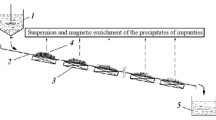Features of the method of multiple-operation magnetic monitoring of ferrous impurities in natural and industrial media are identified and ways of improving the method are proposed. A model that involves autonomous exponential extrapolation of an identified second (tail) segment of a mass-operational dependence is constructed. A formula for use in calculating the total masses and mass fraction of ferrous impurities in samples that have undergone magnetic monitoring is found.


Similar content being viewed by others
References
A. A. Sandulyak, M. N. Polismakova, D.V. Ershov, et al., “Functional extrapolation of mass-operational characteristics of magnetophoresis as a foundation for a precision method of monitoring ferrous particles,” Izmer. Tekhn., No. 8, 57–60 (2010).
GOST 15045–78, Quartz-Feldspar Substances for Structural Ceramics. Technical Conditions.
GOST 22551–77, Quartz Sand, Ground Sandstone, Quartzite, and Vein Quartz for the Glass Industry. Technical Conditions.
GOST 23672–79, Dolomite for the Glass Industry. Technical Conditions.
GOST 21234–75, Ground Talc for the Ceramic Industry. Technical Conditions.
GOST 51289–99, Wheat Flour. General Technical Conditions.
GOST 7022–97, Semolina. Technical Conditions.
GOST 1938–90, Packaged Baukhovi Black Tea. Technical Conditions.
GOST R 51881–2002, Natural Soluble Coffee. General Technical Requirements.
GOST R 50558–93, Industrial Purity. Lubricants and Coolants. General Technical Requirements.
GOST R 51866–2002 (EN 228–2004), Motor Oil. Nonethylene Benzene. Technical Conditions.
GOST 20799–88, Industrial Oils. Technical Conditions.
Resolution No. 118 of the Government of the Russian Federation, On the Approval of Technical Rule “On Requirements for Automotive and Aviation Benzene, Diesel, and Marine Fuel and Fuel for Jet Engines, and Industrial Fuel Oil,” Feb. 27, 2008.
A. V. Sandulyak, D. I. Svistunov, V. A. Ershov, and D. A. Sandulyak, “Ferrous impurities in benzene: micro-operational magnetic monitoring. Expanded histograms,” Dvigatelestroenie, No. 2 (244), 33–38 (2011).
A. V. Sandulyak, A. A. Sandulyak, D. I. Svistunov, et al., “On the capabilities of three-operation (as the minimally necessary) magnetic inspection of ferrous impurities in benzene,” Gruzovik, No. 10, 17–23 (2011).
A. V. Sandulyak, D. I. Svistunov, A. A. Sandulyak, et al., “Operational extrapolatable magnetic monitoring of ferrous impurities in motor oil. Operations–’blocks’ variants,” Tren. Smazka v Mashin. Mekhaniz., No. 12, 32–39 (2011).
A. V. Sandulyak, D. I. Svistunov, A. A. Sandulyak, et al., “Magnetic monitoring of ferrous impurities in industrial and motor oils,” Rus. Eng. Res., 32, No. 4, 56–60 (2012).
A. M. Zholud’ and B. E. Kashevskii, “Dynamics of magnetophoretic separation of a suspension of slightly magnetic microparticles in a high-gradient field of a magnetized rod,” J. Eng. Phys. Thermophys., 82, No. 2, 215–220 (2009).
P. Toneguzzo, G. Viau, and F. Fievet, “Monodisperse ferrous metal particles: Synthesis by chemical routes, size monitoring and magnetic characterizations,” Handbook of Advanced Magnetic Materials (2006), pp. 1193–1242.
É. H. Éfendiyev, R. A. Ali-zade, and V. P. Zubov, “Synthesis of polymer magnetic microspheres and study of their magnetic properties,” Crystallogr. Rep., 50, No. 1, S168–S172 (2005).
GOST 25216–82, Talc and Talc Magnesite. Method of Determining Iron.
GOST 23789–79, Gypsum Binding Materials. Testing Methods.
The present study was carried out with the support from the Russian Foundation for Basic Research (Project No. 16-38-60034 mol.a.dk) and the Ministry of Education and Science of the Russian Federation under State Assignment in the Sphere of Scientific Activity (No. 9.1189.2014/K).
Author information
Authors and Affiliations
Corresponding author
Additional information
Translated from Izmeritel’naya Tekhnika, No. 5, pp. 53–56, May, 2016.
Rights and permissions
About this article
Cite this article
Sandulyak, D.A., Sandulyak, A.A., Sleptsov, V.V. et al. Development of a Combined Empirical and Computational Method of Multiple-Operation Magnetic Monitoring of Ferrous Particles. Meas Tech 59, 526–531 (2016). https://doi.org/10.1007/s11018-016-1002-5
Received:
Published:
Issue Date:
DOI: https://doi.org/10.1007/s11018-016-1002-5




